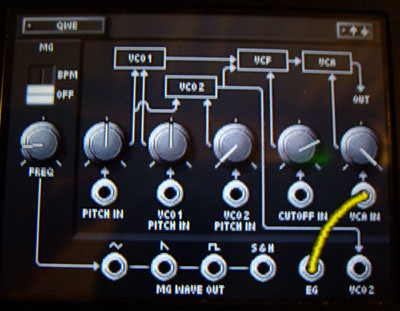This is the 1st track of what's gonna be my 6th Korg DS-10 album (hopefully). The goal here was to make a chiptune-like track with some chords (major, minor, diminished, augmented, in other words, whatever sounded alright). For some reason, I also wanted to end the tune with some kind of build-up.
For the chords, I used three drum channels all loaded with the same sound. The chiptune feel comes from the square wave oscillators. The remaining drum channel and the two main synth voices are used for the melodies (and occasional bass). The tune is in the key of E major.
Can't say that the DS-10 is very chord friendly. Obviously, you have to do triads using three channels (maybe fewer if you want to be clever and use the 2nd oscillator as a note in the triad) and it's fair to say that it would be much easier if you could lay out a chord in one (polyphonic) channel. Dunno if it's worth the effort on the DS-10 to be honest, especially knowing that any DAW can lay out chords in a single channel.
Let's talk about chords for a second or two. The pitch grid on the DS-10 is divided vertically into half-steps (semi-tones) so it's pretty easy to build any kind of chords: you just have to know how to count (to 8 for triads).
A major triad chord is built with 3 notes: the root, a note that's 4 half-steps higher (major third) and a note that's 7 half-steps higher (perfect fifth). In integer notation, it's represented by the triplet 0-4-7.
A minor triad chord is built with 3 notes: the root, a note that's 3 half-steps higher (minor third) and a note that's 7 half-steps higher (perfect fifth). In integer notation, it's represented by the triplet 0-3-7.
A diminished triad chord is built with 3 notes: the root, a note that's 3 half-steps higher (minor third) and a note that's 6 half-steps higher (diminished fifth). In integer notation, it's represented by the triplet 0-3-6.
An augmented triad chord is built with 3 notes: the root, a note that's 4 half-steps higher (major third) and a note that's 8 half-steps higher (augmented fifth). In integer notation, it's represented by the triplet 0-4-8.
When a major interval is decreased by one half-step (semi-tone), it becomes minor.
When a perfect fifth interval is decreased by one half-step, it becomes diminished.
When a perfect fifth interval is increased by one half-step, it becomes augmented.
If, when building chords, you only choose the notes of the scale you are currently in, the chords are said to be diatonic, that is, within the scale. For example, if you are working with a major scale, the diatonic triads are either major, minor or diminished depending on the chord root (check the Harmony post on this very blog for more on diatonic chords).
Anyways, I just want to say that it didn't take too long to make that tune and I think it came out alright (better than expected maybe).
A little note about video editing and youtube ... Because my computer is not so great, the frames I grab (with fraps) are 344x240. This means that on youtube, the only format that's gonna be available is 240p (that represents the height of the video). I usually don't care about that but today was different. Indeed, it would be nice to have the next video format available (360p) for giggles. So, what I did in VirtualDub was to expand the frame to 480x360 without actually resizing the input video, letterbox style (using the video resize filter). Youtube took the bait and the video can now be seen in the 240p and 360p video formats. I am not completely sure what the point of all this is but I am ready to bet it affects the search results (the relevant ones). I have also been told that the sound quality is better when the video definition is itself higher.
And here are, by popular demand, the sound settings for the intro pattern (same settings on the 3 drum channels in order to play chord triads):


Oh man I never thought of using the drum channels to make chords. That's a great idea. I'll have to try it, although you made it sound kind of frustrating.
ReplyDeleteWell, i'm easily frustrated/annoyed. Try it and lemme know. The Korg M01 (out in Japan) can do chords within a channel so it should be easier to deal with. thanks for the comment.
ReplyDeleteHi ! I'm wondering how you come to the synth sound used in the first ten seconds... I really like it ! Can you please describe the method you used to get it ?
ReplyDeleteThanks
Hi. It's 2 square waves (vco1 and vco2). Same patch for all 3 drum channels playing triad chords.
ReplyDeletei am sorry i can't be more precise but i don't have the nds with me.
ReplyDeletedon't worry, i'm not in a hurry ! but it would be appreciated if you could give me a few more details about the settings when you'll get your hands back on it ;)
ReplyDeleteok, i'll look and give you more info. Just remind me in case i forget.
ReplyDeleteok, i've put the settings in the post. Hope that's what you wanted. Cheers, Ugo.
ReplyDeleteThanks a lot I'll try it & let you know if I get the whole thing when I'll get the DS-10 back in my hands. Cheers
ReplyDelete